
In this post, I have made an attempt to present an ideation on the concept of using social media to run e-procurement related queries, campaigns and RFx's cycles. This thereby will render a channel of Sourcing Social Collaboration integrated with Enterprise ERP suites to fulfil all sourcing business function requirements. The below PDF connotes the feasibility to access and utilise professional social networks for facilitating Key sourcing procurement decision making.
The example of parts suppliers selection has been explored to convey the subject ideation,
- Building on the potential behind the follow us on Social Medial Handles to facilitate optimal suppliers sourcing
- Using the follow us social media handles (Twitter + LinkedIn) to derive value via internal procurement collaboration rooms (nerve centers) leading to:
- Social Integration across complete pre-ordering and ordering fraternity within procurement function
- Social Unlearning + Relearning
- Social Evolution for procurement intelligence
The three vital sub sets in a sourcing universal set are substantiated as:
PROCUREMENT
Procurement as a function in an enterprise, controls all purchasing requirements of all cross functional departments and acts as a single point of contact between the enterprise and its value chain of suppliers, vendors. The workflow associated with procurement includes the entire purchase cycle commencing with Purchase request to RFQ’s to Quotation from suppliers to Purchase orders and subsequently the inward receiving of goods or services from the suppliers and acknowledging the goods receipts into own stocks subsequent to quality check clearances of received quantity.
- Procurement, pre-ordering, and ordering fraternity are held accountable for sourcing, managing, and transacting with suppliers for an organization.
- Different LOB’s/functions within an organization set-up communicate with procurement for material/part/service requirements making procurement a diverse team.
- Above instance provides scope for collaboration to optimize spends.
SOCIAL INTEGRATION
Social integration implies the alignment of procurement function with the various Social collaboration tools available in market to establish a social media connect on daily activities. By ensuring an integration with the social media tools, there runs a concurrent transparency with procurement activities related to sourcing and selection of suppliers with more visibility on the professional social network. Social integration enables visibility with related procurement groups globally and regionally, also keeping abreast with the latest happenings, changes in the procurement ecosystem.
- Social media handles of Twitter, and LinkedIn provide for both external and internal closed procurement group chat rooms.
- Twitter as a micro-blogging contingency can be leveraged as a RFI/Q’s posts publisher enabling global/local connect.(Successful campaign of mass recruitment drive by HCL @twitter using #CoolestInterviewEver)
- Yammer allows for enterprise wide collaboration with diverse SPOC’s from procurement allowing optimal supplier selection that are concurrent suppliers across different requirements.
SOCIAL UNLEARNING + RELEARNING
Social integration implies the alignment of procurement function with the various Social collaboration tools available in market to establish a social media connect on daily activities. By ensuring integration with the social media tools, there runs a concurrent transparency with procurement activities related to sourcing and selection of suppliers with more visibility on the professional social network. Social integration enables visibility with related procurement groups globally and regionally, also keeping abreast with the latest happenings, changes in the procurement ecosystem.
- Social media analytic tools like Hootsuite, followerwonk, simply measured, thoughtbuzz are major tools equipped to deliver analysis of social media influence and social reputation management specifically from professional network using LinkedIn and Twitter analytics.
- Facilitating supplier activity, behavioral, and reputation learning across social professional network
Eventually a SOCIAL EVOLUTION in the work modus operandi will get nurtured:
With the maturity in social collaboration strategy and execution, the eventual evolution in social professional network activity would empower to pursue selection of sourcing with cost optimization, risk balanced parameters, along with seamless connect with preferred suppliers.
Thus facilitating and servicing requirements in a timely basis without affecting Turnaround times and delivery schedules in procurement.
Promoting Twitter campaigns, LinkedIn procurement group proliferations, Yammer collaboration as a procurement nerve center
Frequently Asked Questions (FAQs)
Enterprise asset management (EAM) involves the management of mission critical assets of an organization throughout each asset's lifecycle. EAM is used to plan, optimize, execute, and track the needed maintenance activities with the associated priorities, skills, materials, tools, and information. The aim is to optimize the quality and utilization of assets throughout their lifecycle, increase productive uptime and reduce operational costs.
Enterprise asset management (EAM) involves the management of the maintenance of physical assets of an organization throughout each asset's lifecycle. EAM is used to plan, optimize, execute, and track the needed maintenance activities with the associated priorities, skills, materials, tools, and information.
The software helps in effective maintenance of assets through preventive, predictive, shutdown and breakdown maintenance strategies. The system also helps enterprises mitigate equipment risks by enhanced safety standards. The streamlined operations and improved asset performance helps organizations increase their investment effectiveness.
EAM is important because it helps organizations track, assess, manage and optimize asset quality and reliability. Asset intensive Organizations have hundreds, thousands, even millions of assets which needs to be maintained to maximize / optimize life of these assets to increase the return on investment.
The key features of effective EAM are:
- Work management.
- Maintenance Strategies (Preventive/ Predictive / Breakdown / Shutdown).
- Planning and scheduling.
- Supply chain management.
- Health and safety.
- Mobility.
- Analytics.
- Improved Asset Health at reduced cost through data driven maintenance Programs
- Complete visibilityon entire maintenance data across Equipment, across Models, across Branches to aid in analysis & decision making such as to Repair or Replace the Equipment
- Insightful analysis of Inspection Data to improve customer satisfaction
- Effective maintenance management enhanced by predictive maintenance and inbuilt analytics
- Increased reliability and safety, keeps complete track of all the inspections & calibration schedules
- Mobile Application enables users to execute work while “in the field” leading to minimized non-productive time and increased productivity and reduces duplication of work and human errors in recording information.
- Quick turnaround time through Actionable Notification & Alerts for every process in real time and accessible anytime and anywhere.
- Improved Regulatory Part of asset management involves the implementation of better O&M practices, which can significantly improve compliance.
Asset Intensive companies under the following Industries :
- Ports
- Cement and Mining
- Utilities
- Fleet Maintenance
- Equipment Rental
- Other Manufacturing
- Real Estate & Infrastructure
- Power Generation
Contact us for a meeting and schedule a demo
This differs on case to case basis, based on the type of installation and unique industry specific requirements. Contact us for a meeting and schedule a demo.
This differs on case to case basis, based on the type of installation and unique industry specific requirements. Contact us for a meeting and schedule a demo.
Stay Connected, follow us on LinkedIn / Twitter to know more about EAM Software latest trends.


